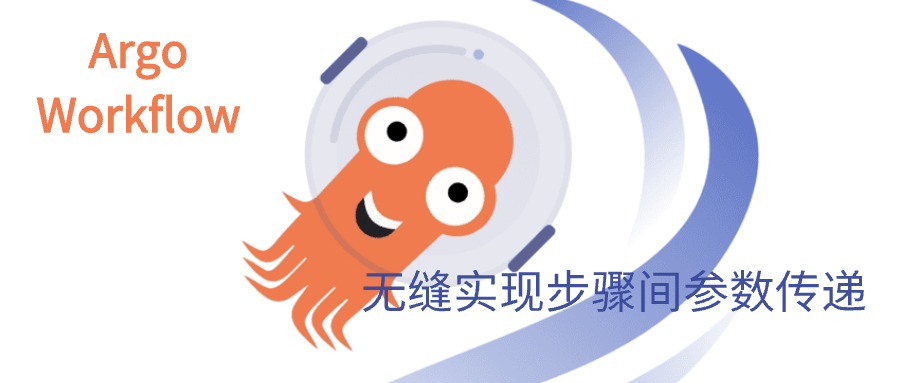ArgoWorkflow教程(六)---无缝实现步骤间参数传递

之前我们分析了,Workflow、WorkflowTemplate 、template 3 者之间如何传递参数。
本文主要分析同一个 Workflow 中的不同 step 之间实现参数传递,比如将上一个步骤的输出作为下一个步骤的结果进行使用(而非以文件方式传递)。
1. 概述
然后就是之前只分析了 Workflow、WorkflowTemplate 、template 3 者之间如何传递参数,今天继续分析一下步骤之间如何传递参数。
要实现步骤间参数传递,需要实现两个功能:
-
1)导出结果
-
2)导入参数
基于之前的知识,要实现这两个功能,可以想到的一种方式就是使用 artifact:
- 导出结果:将参数写入文件,然后以 artifact 保存到 s3
- 导入参数:下一个 step 下载 artifact 并从中获取参数。
确实可以实现功能,但是有点蹩脚,毕竟 artifact 主要是用于保存文件的。argoworkflow 中也直接提供了对应的 feature 来供大家使用。
2. 步骤间参数传递
- 将结果导出为 Output Parameter
- 将上一步的 Output Parameter 导入为当前步骤的 Input Parameter
完整 Demo 如下:
apiVersion: argoproj.io/v1alpha1
kind: Workflow
metadata:
generateName: output-parameter-
spec:
entrypoint: output-parameter
templates:
- name: output-parameter
steps:
- - name: generate-parameter
template: whalesay
- - name: consume-parameter
template: print-message
arguments:
parameters:
# Pass the hello-param output from the generate-parameter step as the message input to print-message
- name: message
value: "{{steps.generate-parameter.outputs.parameters.hello-param}}"
- name: whalesay
container:
image: docker/whalesay:latest
command: [sh, -c]
args: ["echo -n hello world > /tmp/hello_world.txt"] # generate the content of hello_world.txt
outputs:
parameters:
- name: hello-param # name of output parameter
valueFrom:
path: /tmp/hello_world.txt # set the value of hello-param to the contents of this hello-world.txt
- name: print-message
inputs:
parameters:
- name: message
container:
image: docker/whalesay:latest
command: [cowsay]
args: ["{{inputs.parameters.message}}"]
导出结果
- name: whalesay
container:
image: docker/whalesay:latest
command: [sh, -c]
args: ["echo -n hello world > /tmp/hello_world.txt"] # generate the content of hello_world.txt
outputs:
parameters:
- name: hello-param # name of output parameter
valueFrom:
path: /tmp/hello_world.txt # set the value of hello-param to the contents of this hello-world.txt
首先是 step 的内容,这里为了简单,就只有一个 echo 命令,将结果(hello world)写入到文件
/tmp/hello_world.txt 中。
然后就是到处结果了:
outputs:
parameters:
- name: hello-param # name of output parameter
valueFrom:
path: /tmp/hello_world.txt # set the value of hello-param to the contents of this hello-world.txt
定义了一个 output 参数,名为 hello-param,该参数的 value 从 /tmp/hello_world.txt 文件中获取,最终得到的 value 就是之前写入的 hello world。
至此,我们就讲当前步骤的结果导出成了一个 Output Parameter,可以在后续步骤使用了。
导入参数
后续步骤,其实很简单,和普通步骤一样的,通过 Input Parameter 定义参数,然后在使用的使用通过语法{{inputs.parameters.name}} 引用即可。
- name: print-message
inputs:
parameters:
- name: message
container:
image: docker/whalesay:latest
command: [cowsay]
args: ["{{inputs.parameters.message}}"]
唯一区别在于,这个参数的来源,之前我们都是直接讲参数定义在 Workflow 中的,这里需要改成引用之前步骤导出的 Output Parameter,就像这样:
spec:
entrypoint: output-parameter
templates:
- name: output-parameter
steps:
- - name: generate-parameter
template: whalesay
- - name: consume-parameter
template: print-message
arguments:
parameters:
# Pass the hello-param output from the generate-parameter step as the message input to print-message
- name: message
value: "{{steps.generate-parameter.outputs.parameters.hello-param}}"
在 arguments.parameters 中直接引用了之前步骤的 Output Parameter,语法为 {{steps.$stepName.outputs.parameters.$parameterName}}。
之前我们导出结果的步骤名为 generate-parameter,然后导出的参数名为 hello-param,因此这里就使用{{steps.generate-parameter.outputs.parameters.hello-param}} 来引用该参数。
内置的 result 参数
除了我们手动导出的参数之外,ArgoWorkflow 还会默认生成一个 Output Parameter,他就是 result。
和其他 Output Parameter 一样,可以通过 {{steps.$stepName.outputs.parameters.$parameterName}} 语法进行引用。
这个 result 参数会捕获最大 256KB 的标准输出作为 value,因此他可以包含以下内容:
- 1)script 的运行结果
- 2)容器的标准输出
- 3)…
只要是在容器中输出到标准输出的,内容都可以被 result 捕获。
**【ArgoWorkflow 系列】**持续更新中,搜索公众号【探索云原生】订阅,文章。

3. 小结
本文主要分析了 Argo 中的 Workflow 中怎么传递参数还是比较简单的:
- 1)通过 Output Parameter 导出参数
- 2)在 arguments.parameters 中引用上一步导出的参数
最后介绍了一下内置的 result Output Parameter ,可以用于获取容器中的标准输出。
